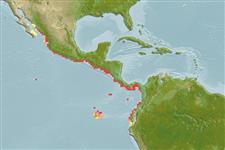Common names from other countries
Environment: milieu / climate zone / depth range / distribution range
Ecologia
; estuarina; intervalo de profundidade 0 - 20 m (Ref. 109200), usually 0 - 15 m (Ref. 80605). Subtropical; 26°C - 38°C (Ref. 68684); 27°N - 4°S, 114°W - 77°W (Ref. 109211)
Eastern Pacific: From Laguna Ballena, Baja California Sur, Mexico to Bahía de Tumbes, Peru.
Length at first maturity / Tamanho / Peso / Idade
Maturity: Lm ? range ? - ? cm
Found in salinities from 30-40 ppt in Baja California Sur, Mexico (Ref. 68684). Occurs in mangrove estuaries (Ref. 80605). Lives mainly in or near the red mangrove Rhizophora mangle (Ref. 109200) as well among the roots of Avicennia germinans and Laguncularia racemosa (Ref. 121717). Individuals are found at about 15 cm deep in level muddy bottom among the prop roots of Rhizophora spp. (Ref. 80605), in intertidal mud flats between mangrove trees and the low tide line (Ref. 109200).
Life cycle and mating behavior
Maturidade | Reprodução | Desova | Ovos | Fecundidade | Larvas
Members of the class Bivalvia are mostly gonochoric, some are protandric hermaphrodites. Life cycle: Embryos develop into free-swimming trocophore larvae, succeeded by the bivalve veliger, resembling a miniature clam.
Turgeon, D.D., J.F. Quinn Jr., A.E. Bogan, E.V. Coan, F.G. Hochberg, W.G. Lyons, P.M. Mikkelsen, R.J. Neves, C.F.E. Roper, G. Rosenberg, B. Roth, A. Scheltema, F.G. Thompson, M. Vecchione and J.D. Willams. 1998. (Ref. 1667)
Categoria na Lista Vermelha da IUCN (Ref. 130435)
Categoria CITES (Ref. 108899)
Not Evaluated
Not Evaluated
Utilização humana
Pescarias: espécies comerciais
| FishSource |
Ferramentas
Mais informação
Idade/TamanhoCrescimentoComprimento-pesoComprimento-comprimentoMorfologiaLarvasAbundância
Fontes da internet
Estimates based on models
Preferred temperature
(Ref.
115969): 24.3 - 29.1, mean 27.5 (based on 139 cells).
Resiliência
Elevada, tempo mínimo de duplicação da população menor que 15 meses (K=0.09-1.85).
